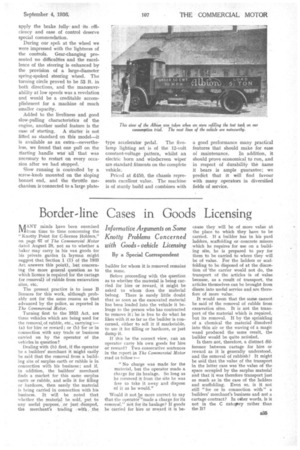Border-line Cases in Goods Licensing
Page 49

If you've noticed an error in this article please click here to report it so we can fix it.
Informative Arguments on Some Knotty Problems Concerned with Goods vehicle Licensing
By a Special Correspondent lk ff ANY minds have been exercised liflfrom time to time concerning the "Knotty Point for C-licence Holders." on page 67 of The Commercial Motor dated August 28, not as to whether a baker may carry in his van goods for his private garden (a layman might suggest that Section 1 (1) of the 1933 Act answers this point), but concerning the more general question as to which licence is required for the cartage for removall of rubble from excavation sites, etc.
The present practice is to issue B licences for this work, although probably not for the same reason as that advanced by the police, as reported in The Commercial Motor, Turning first to the 1933 Act, art these vehicles which are being used for the removal, of rubble, etc., carrying :— (a) for hire or reward ; or (b) for or in connection with any trade or business carried On by the operator of the vehicles in question?
Dealing with (b) first, if the operator be a builders' merchant it might easily he said that the removal from a building site of surplus earth or rubble is in connection with his business ; and if, in addition, the builders' merchant finds a market for this same surplus earth or rubble, and sells it for filling or hardcore, then surely the material is being carried in connection with his business. It will be noted that whether the material he sold, put to any useful purpose, or justr.dumped, the merchant's trading • with the
builder for whom it is removed remains the same.
Before proceeding with the question as to whether the material is being carried for hire or reward, it might be asked to whom does the material belong. There is surely little doubt that so soon as the exoavated material has been loaded into the vehicle it belongs to the person who has contracted to remove it ; he is free to do what he likes with it so far as the builder is concerned, either to sell it if marketable, to use it for filling or hardcore, or just dump it.
It this be the correct view, can an operator carry his own goods for hire or reward? Two consecutive sentences in the report in The Commercial Motor read as follow No charge was made for the material, but the operator made a charge for its haulage. So long as he removed it from the site he was free to take it away and dispose of it as he would."
Would it not be more correct to say that the operator "made a charge for its removal," riot, for its haulage? If goods be carried for hire or reward it is be cause they will be of more value at the place to which they have to be carried. If a builder has in his yard ladders, scaffolding or -concrete mixers which he roquires for use on a building site, he is prepared to pay for them to be carried to where they will be of value. For the ladders or scaffolding to be disposed of at the discretion of 'the carrier would not do, the transport of the articles is of value because, as a result of transport, the articles themselves can be brought from disuse into useful service and, are therefore of more value.
It would seem that the same cannot be said of the removal of rubble from excavation sites. It is not the transport of the material which is required, hut its removal. If by the sprinkling of a chemical the material dissolved into thin air or the waving of a magic wand produced the same result, the builder would be quite satisfied.
Is there not_ therefore, a distinct difference between cartage for hire or reward as it is generally understood, and the removal of rubbish? It might be said that the value of the transport in the latter case was the value of the space occupied by the surplus material and that it was therefore transport just as much as in the case of the ladders and scaffolding. Even so, is it not still"for or in connection with" a builders' merchant's business and not a cartage contract? In other words, is it not in the C category rather than the B?




























































































